一般过去时
图片预览
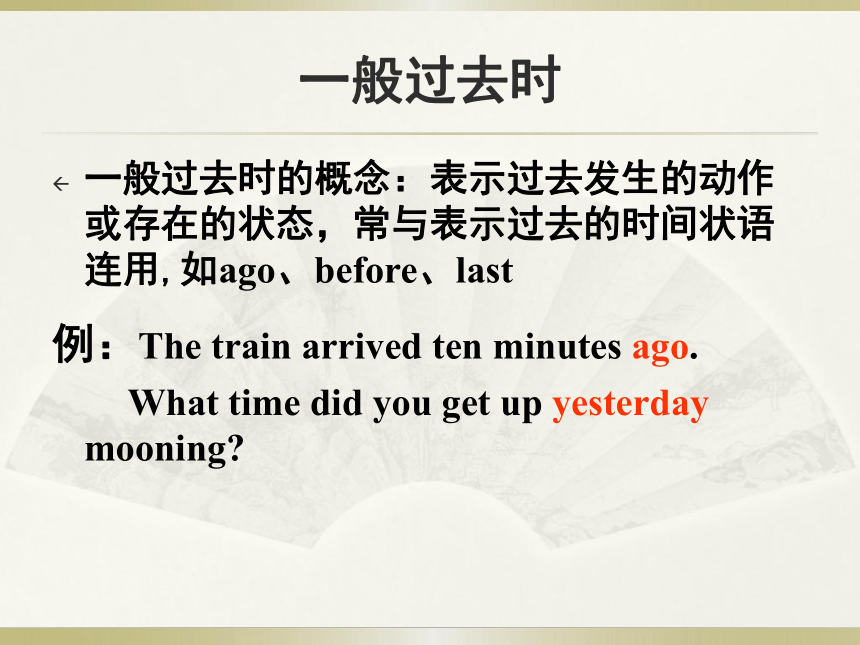
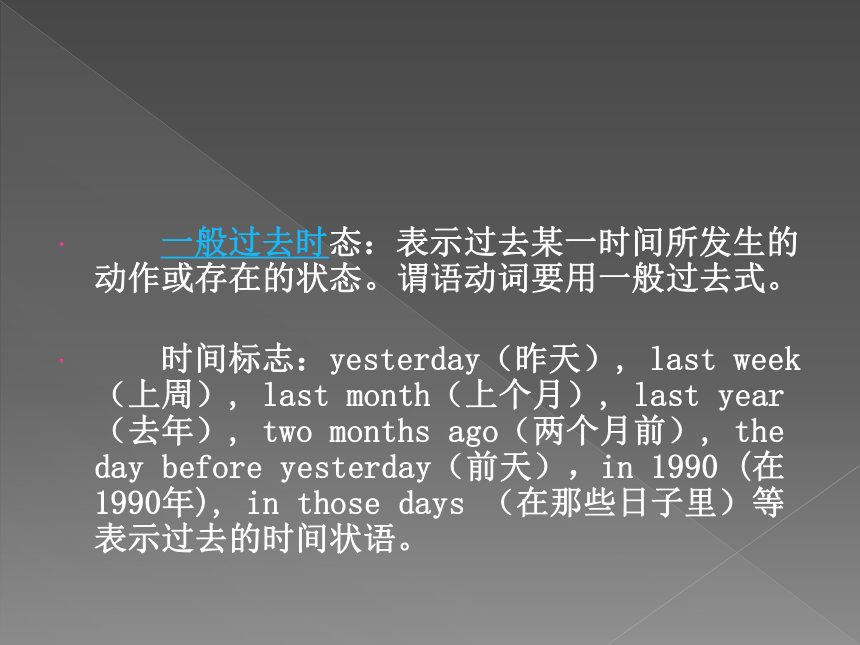
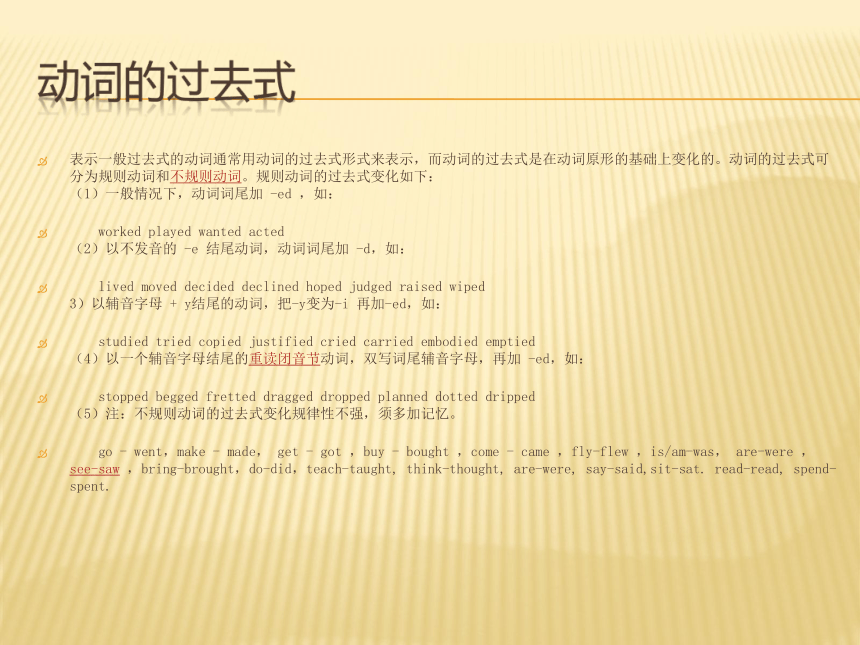
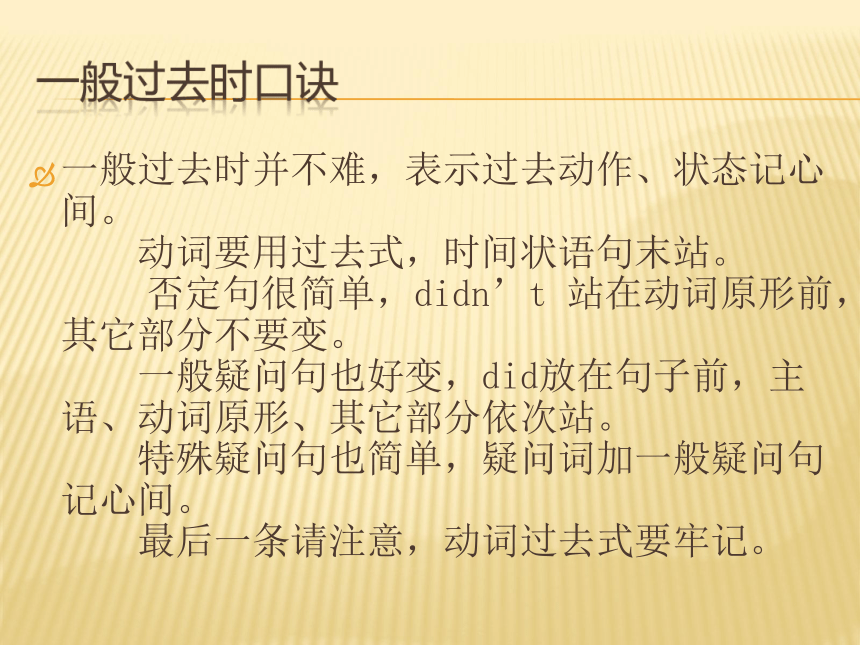
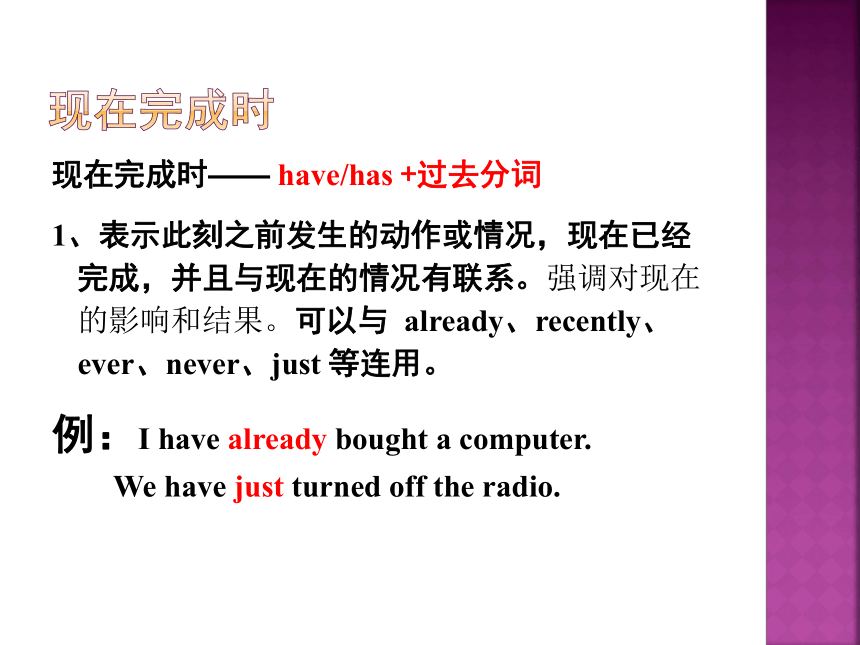
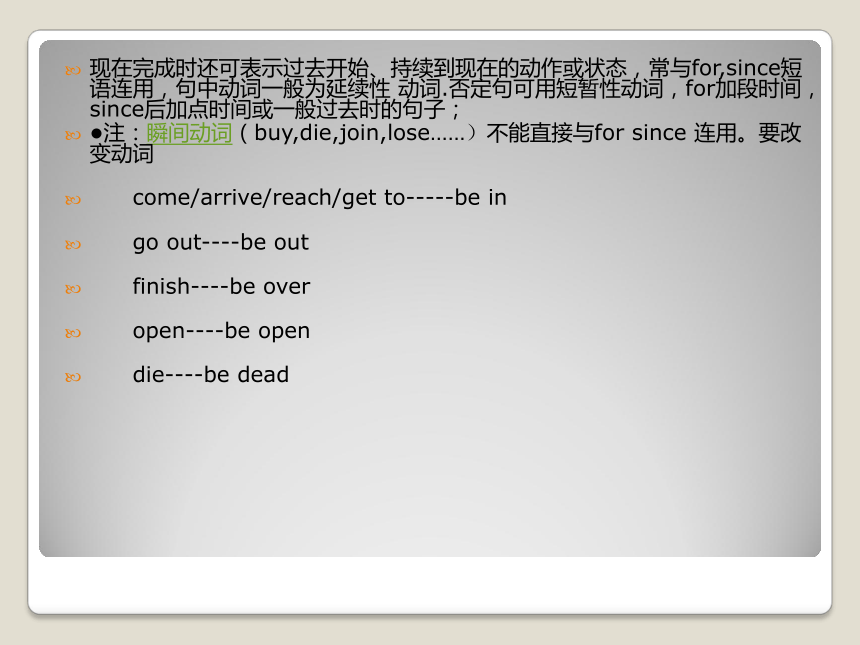
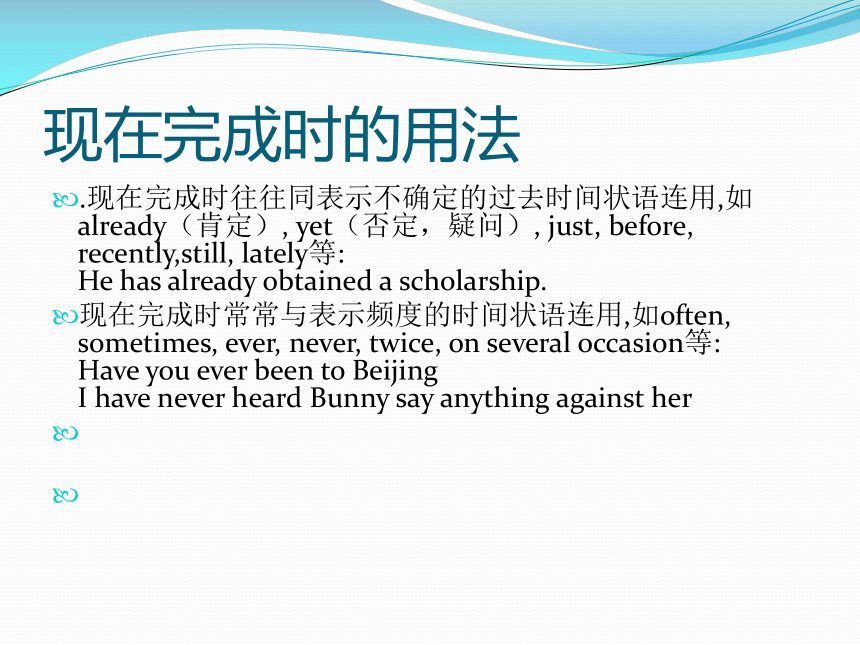
文档简介
课件16张PPT。一般过去时一般过去时的概念:表示过去发生的动作或存在的状态,常与表示过去的时间状语连用,如ago、before、last
例:The train arrived ten minutes ago.
What time did you get up yesterday mooning?
一般过去时态:表示过去某一时间所发生的动作或存在的状态。谓语动词要用一般过去式。
时间标志:yesterday(昨天), last week(上周), last month(上个月), last year(去年), two months ago(两个月前), the day before yesterday(前天),in 1990 (在1990年), in those days (在那些日子里)等表示过去的时间状语。 动词的过去式表示一般过去式的动词通常用动词的过去式形式来表示,而动词的过去式是在动词原形的基础上变化的。动词的过去式可分为规则动词和不规则动词。规则动词的过去式变化如下: (1)一般情况下,动词词尾加 -ed ,如:
worked played wanted acted (2)以不发音的 -e 结尾动词,动词词尾加 -d,如:
lived moved decided declined hoped judged raised wiped 3)以辅音字母 + y结尾的动词,把-y变为-i 再加-ed,如:
studied tried copied justified cried carried embodied emptied (4)以一个辅音字母结尾的重读闭音节动词,双写词尾辅音字母,再加 -ed,如:
stopped begged fretted dragged dropped planned dotted dripped (5)注:不规则动词的过去式变化规律性不强,须多加记忆。
go - went,make - made, get - got ,buy - bought ,come - came ,fly-flew ,is/am-was, are-were ,see-saw ,bring-brought,do-did,teach-taught, think-thought, are-were, say-said,sit-sat. read-read, spend-spent.一般过去时口诀一般过去时并不难,表示过去动作、状态记心间。 动词要用过去式,时间状语句末站。 否定句很简单,didn’t?站在动词原形前,其它部分不要变。 一般疑问句也好变,did放在句子前,主语、动词原形、其它部分依次站。 特殊疑问句也简单,疑问词加一般疑问句记心间。 最后一条请注意,动词过去式要牢记。 现在完成时现在完成时—— have/has +过去分词
1、表示此刻之前发生的动作或情况,现在已经完成,并且与现在的情况有联系。强调对现在的影响和结果。可以与 already、recently、ever、never、just 等连用。
例:I have already bought a computer.
We have just turned off the radio.
现在完成时还可表示过去开始、持续到现在的动作或状态,常与for,since短语连用,句中动词一般为延续性 动词.否定句可用短暂性动词,for加段时间,since后加点时间或一般过去时的句子;
●注:瞬间动词(buy,die,join,lose……)不能直接与for since 连用。要改变动词
come/arrive/reach/get to-----be in
go out----be out
finish----be over
open----be open
die----be dead 现在完成时的用法.现在完成时往往同表示不确定的过去时间状语连用,如already(肯定), yet(否定,疑问), just, before, recently,still, lately等: He has already obtained a scholarship.
现在完成时常常与表示频度的时间状语连用,如often, sometimes, ever, never, twice, on several occasion等: Have you ever been to Beijing I have never heard Bunny say anything against her
现在完成时还往往可以同包括现在时间在内的时间状语连用,如now, up to these few
days/weeks/months/years, this morning/week/month/year, just, today, up to present, so far等: Peter has written six papers so far. Man has now learned to release energy from the nucleus of the atom.
现在完成时还可以用来表示过去的一个时间到现在这段时间内重复发生的动作. We have had four tests this semester. ◆现在完成时 VS.一般过去式1. 一般过去时表示过去某个时间发生的事、存在的状态或经常发生的动作。说话的侧重点只在于陈述一件过去的事情,不强调对“现在”产生的影响。如:
He visited Guilin in 1998.他1998年参观过桂林。2. 现在完成时表示动作发生在过去,对现在造成了影响或产生了结果。不与确定的过去时间状语连用。如: Jill has bought a new computer.吉尔买了一台新电脑。(着重点是现在有了一台新电脑) 两种时态的区分 (1)一般过去时的谓语动词用过去式,而现在完成时的谓语基本构成是“助动词have /has +过去分词”。如: (2)一般过去时通常与表示过去的时间状语连用。如:yesterday, last week, two years ago, just now, in 2002等;而现在完成时则常与just, already, ever, never等副词和these days, this week, since..., for...等表示一段时间的状语连用。看看以下的几组句子,有什么区别? ① Have you seen the film?(A) Did you see the film?(B) [说明] 你看过这部电影吗?(A)句强调的是被问者对剧情是否了解;(B)句强调的是看这部电影的动作是否发生过,并不强调是否知道其内容。② How has he done it?(A) How did he do it?(B) [说明]他是怎么做的这件事?(A)句强调的是他做这件事的方式对现在产生了某种影响;(B)句单纯的 询问做这件事的方式。—When will you tell him the good news??
—I will tell him about it as soon as he_____back.
A.comes B.came?
C.will come D.is comingMy mother_________the windows already,so the room looks much brighter.[2003,河南]?
A.has cleaned B.had cleaned?
C.is cleaning
D.Cleaned ?Thank You
例:The train arrived ten minutes ago.
What time did you get up yesterday mooning?
一般过去时态:表示过去某一时间所发生的动作或存在的状态。谓语动词要用一般过去式。
时间标志:yesterday(昨天), last week(上周), last month(上个月), last year(去年), two months ago(两个月前), the day before yesterday(前天),in 1990 (在1990年), in those days (在那些日子里)等表示过去的时间状语。 动词的过去式表示一般过去式的动词通常用动词的过去式形式来表示,而动词的过去式是在动词原形的基础上变化的。动词的过去式可分为规则动词和不规则动词。规则动词的过去式变化如下: (1)一般情况下,动词词尾加 -ed ,如:
worked played wanted acted (2)以不发音的 -e 结尾动词,动词词尾加 -d,如:
lived moved decided declined hoped judged raised wiped 3)以辅音字母 + y结尾的动词,把-y变为-i 再加-ed,如:
studied tried copied justified cried carried embodied emptied (4)以一个辅音字母结尾的重读闭音节动词,双写词尾辅音字母,再加 -ed,如:
stopped begged fretted dragged dropped planned dotted dripped (5)注:不规则动词的过去式变化规律性不强,须多加记忆。
go - went,make - made, get - got ,buy - bought ,come - came ,fly-flew ,is/am-was, are-were ,see-saw ,bring-brought,do-did,teach-taught, think-thought, are-were, say-said,sit-sat. read-read, spend-spent.一般过去时口诀一般过去时并不难,表示过去动作、状态记心间。 动词要用过去式,时间状语句末站。 否定句很简单,didn’t?站在动词原形前,其它部分不要变。 一般疑问句也好变,did放在句子前,主语、动词原形、其它部分依次站。 特殊疑问句也简单,疑问词加一般疑问句记心间。 最后一条请注意,动词过去式要牢记。 现在完成时现在完成时—— have/has +过去分词
1、表示此刻之前发生的动作或情况,现在已经完成,并且与现在的情况有联系。强调对现在的影响和结果。可以与 already、recently、ever、never、just 等连用。
例:I have already bought a computer.
We have just turned off the radio.
现在完成时还可表示过去开始、持续到现在的动作或状态,常与for,since短语连用,句中动词一般为延续性 动词.否定句可用短暂性动词,for加段时间,since后加点时间或一般过去时的句子;
●注:瞬间动词(buy,die,join,lose……)不能直接与for since 连用。要改变动词
come/arrive/reach/get to-----be in
go out----be out
finish----be over
open----be open
die----be dead 现在完成时的用法.现在完成时往往同表示不确定的过去时间状语连用,如already(肯定), yet(否定,疑问), just, before, recently,still, lately等: He has already obtained a scholarship.
现在完成时常常与表示频度的时间状语连用,如often, sometimes, ever, never, twice, on several occasion等: Have you ever been to Beijing I have never heard Bunny say anything against her
现在完成时还往往可以同包括现在时间在内的时间状语连用,如now, up to these few
days/weeks/months/years, this morning/week/month/year, just, today, up to present, so far等: Peter has written six papers so far. Man has now learned to release energy from the nucleus of the atom.
现在完成时还可以用来表示过去的一个时间到现在这段时间内重复发生的动作. We have had four tests this semester. ◆现在完成时 VS.一般过去式1. 一般过去时表示过去某个时间发生的事、存在的状态或经常发生的动作。说话的侧重点只在于陈述一件过去的事情,不强调对“现在”产生的影响。如:
He visited Guilin in 1998.他1998年参观过桂林。2. 现在完成时表示动作发生在过去,对现在造成了影响或产生了结果。不与确定的过去时间状语连用。如: Jill has bought a new computer.吉尔买了一台新电脑。(着重点是现在有了一台新电脑) 两种时态的区分 (1)一般过去时的谓语动词用过去式,而现在完成时的谓语基本构成是“助动词have /has +过去分词”。如: (2)一般过去时通常与表示过去的时间状语连用。如:yesterday, last week, two years ago, just now, in 2002等;而现在完成时则常与just, already, ever, never等副词和these days, this week, since..., for...等表示一段时间的状语连用。看看以下的几组句子,有什么区别? ① Have you seen the film?(A) Did you see the film?(B) [说明] 你看过这部电影吗?(A)句强调的是被问者对剧情是否了解;(B)句强调的是看这部电影的动作是否发生过,并不强调是否知道其内容。② How has he done it?(A) How did he do it?(B) [说明]他是怎么做的这件事?(A)句强调的是他做这件事的方式对现在产生了某种影响;(B)句单纯的 询问做这件事的方式。—When will you tell him the good news??
—I will tell him about it as soon as he_____back.
A.comes B.came?
C.will come D.is comingMy mother_________the windows already,so the room looks much brighter.[2003,河南]?
A.has cleaned B.had cleaned?
C.is cleaning
D.Cleaned ?Thank You
